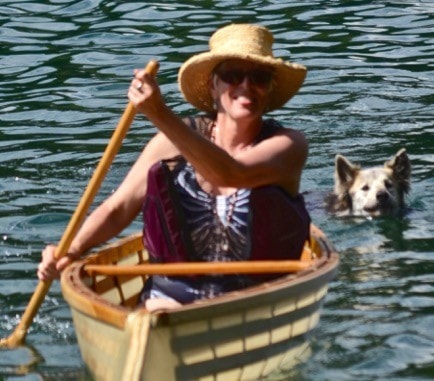Potential changes at Grohman Narrows made the news again recently, as residents of the region contemplated a BC Hydro proposal to dredge the river-bed west of Nelson in order to increase power potential through downstream dams. At the same time, this plan would offer more stability for flood control on Kootenay Lake.
The meeting was a reminder that our corner of Super Natural British Columbia may look beautiful and seem wild, but another reality governs the history and the contemporary state of our water.
Many people are surprised to learn that Kootenay Lake and its West Arm once experienced spring floods that rose up to 20 feet above the current lake level. One of these drastic floods stranded a newly-built Nelson from the outside world in 1894, despite dredging and blasting of rock at Grohman Narrows in the 1880s by the entrepreneur and eccentric who bears its name: W.A. Baillie Grohman.
Further dredging in the late 1930s by West Kootenay Power and Light (the original owner and operator of dams west of Nelson, today absorbed into FortisBC) opened up the channel some more, decreasing flood extremes further, and increasing hydro-power potential. Floods have not stopped happening, but our ability to control water has given us a (some would say false) sense of security.
Enter the titan of all dam plans — the Columbia River Treaty (1964). Construction of two dams linked to the treaty — the Libby on the Kootenay River in Montana (1973) and the Duncan, at the north end of Kootenay Lake (1967) — brought even more water stability in the Kootenay Lake/Arm system. Homes constructed in the 1980s and ’90s on West Arm flood plains would not have been possible before these projects.
Yet it’s the old saw: stability enhances certainty and brings calm. It can also challenge or even destroy vitality. Nature prefers variability, and that’s any successful ecosystem’s best-kept secret. Human history around the globe is full of examples of our efforts to control or even entirely suppress the variability in natural systems in order to enhance agriculture, or facilitate commerce, or protect our lives.
When human capacity in science and engineering operated at a reduced scale, our impacts had a weaker register. The 20th century resulted in a significant up-tick in water-storage technology, namely through the use of concrete and mega-dumptrucks. The era of mega-projects brought a whole new meaning to water management, and with it came ecological changes so abrupt and devastating they have not yet been fully measured.
When I attended a Grohman meeting a year or so ago, I could hear the frustration of local people that had its roots deeper than the current proposal. While on the surface of things, the debate about Grohman Narrows is focused on lake levels, fish health and ferry docks, underneath it all is our region’s troubled history of corporate water management.
My knowledge and understanding of water history has led me into all sorts of interesting projects, one of which is as guest-curator for a new exhibit opening at Touchstones Nelson on Friday at 7 p.m., part of the Blue Night celebration.
This award-winning exhibit looks at the key historical events before during and after the Columbia River Treaty, and presents some pretty fine art and artifacts related to land and water history. A decade ago, I told the story of the Columbia at the Kootenay Storytelling Festival. A new edition of that poetic tribute to the Columbia, The Heart of the River will also be released that weekend, illustrated exquisitely by Nichola Lytle of Pink Dog Designs.
On Saturday at 1 p.m. I will give a talk at Touchstones on the Columbia River Treaty, titled Is it Sustainable? Please join me to celebrate our region’s water history and discuss possibilities for the future.
